Ba Ria-Vung Tau is implementing comprehensive infrastructure projects to connect the region, including the expanded coastal road Ho Tram, which is motivating resort real estate projects to keep up with the recovery cycle.
Waves of infrastructure are moving strongly
From an overall perspective, in recent times, Binh Chau-Ho Tram has become the South’s sole 5-star resort capital, with a growing transportation infrastructure system. Major projects connecting to Ho Tram are expected to be completed in 2023–2025, giving a boost to the real estate market in the area.
Specifically, the coastal road DT994, stretching 77km from Vung Tau City to Binh Chau-Xuyen Moc, will be expanded from two to six lanes this year. The Bien Hoa-Vung Tau motorway, which will significantly reduce travel time to Binh Chau, has commenced construction in 2023. Additionally, Loc An Airport, around 25 minutes from Binh Chau, has been approved for investment.
In particular, the Long Thanh International Airport, set to open in 2025, will be Vietnam’s largest international airport, capable to handle all international flights to the country. It will be the closest destination to coastal tourist areas, allowing visitors to connect directly without domestic transfers.

This is a significant boost to the tourism industry, creating the foundation for the rise in real estate values. According to the law of supply and demand, real estate prices will increase sharply when infrastructure is completed, and buyers will have to pay threefold the current value. Furthermore, this advantage also helps the resort real estate market in this area deal with the existing issues.
Depending on its attraction and unique natural conditions, Ho Tram has opened up a high-end natural resort real estate sector. Along with the potential for tourism development and a highly interregional connectivity infrastructure system, it is expected to become the most valuable location.
Projects prepare for the recovery phase
In fact, resort real estate is usually among the last to bounce back in the market’s recovery cycle after a slowdown, but certain projects, such as Lagoona Binh Chau, can benefit from early recovery due to infrastructure developments in the Ho Tram area.
The growth prospects of peripheral infrastructure facilities and the development of the coastal road are improving the recognition of projects in the area, which encourages investors to carry on executing their resort real estate projects and take advantage of the investment opportunities available.
The investor Dat Gia recently held a groundbreaking ceremony for Wyndham Grand Lagoona Binh Chau Resort Zone to coincide with the completion of the coastal road project, following other projects that got off the ground in the middle of the year, including Lagoona Center and Zone A infrastructure, to hand over the properties to customers.
The Wyndham Grand Lagoona Binh Chau Resort Zone covers an area of 17.39 hectares and includes 5-star-standard hotels, lakefront villas, riverfront villas, and beachfront villas. The investor designed all of the accommodations to ensure an optimal connection with nature. Therefore, customers will always feel the fresh energy of the Ho Tram Sea and the adjacent Phuoc Buu forest.

The completed project is expected to provide over 1,000 hotel rooms, meeting the demand for unique coastal forest resorts in the Ho Tram market. Wyndham Grand, a distinctive brand under the Wyndham Hotels and Resorts group, will manage and operate all mentioned items, ensuring quality and potential investment profits for customers.
The developer’s current technical solutions demonstrate a clear recovery strategy, prioritizing core values and infrastructure completion points. They are investing in resort properties that follow the latest trends and exhibit high levels of completion, resulting in clear effectiveness.
In reality, despite the ups and downs of the market, investors remain interested in second homes due to the dual value they offer as both vacation havens and investment assets. Only projects that are carefully invested in and fulfill the needs of customers can generate an exceptional attraction.
The resort real estate sector is expected to regain its vigor at the beginning of the following year due to increased public investment and improved legal factors, benefiting those projects that are well-prepared to seize the opportunities of the recovery cycle.











